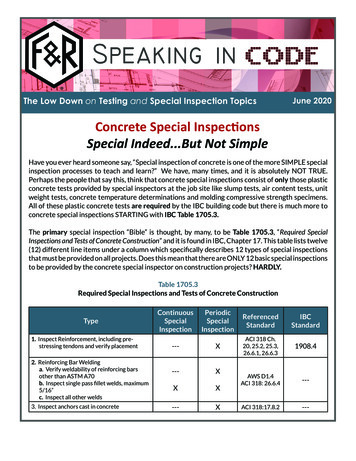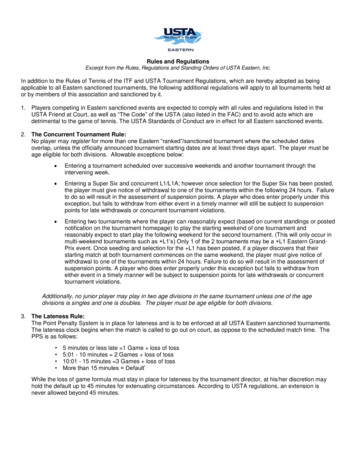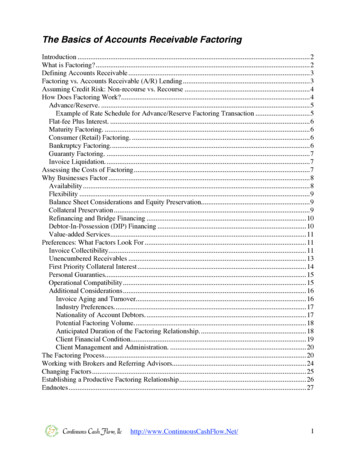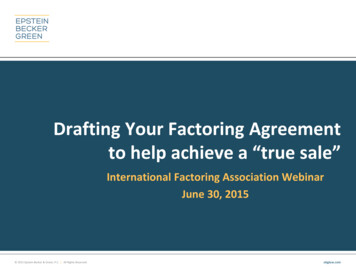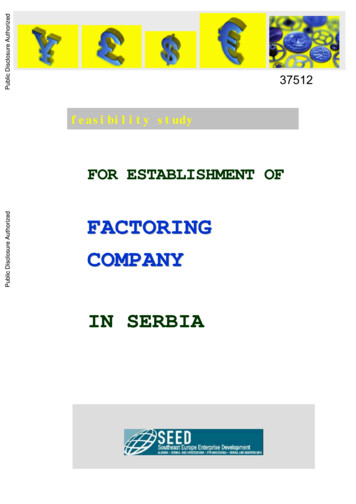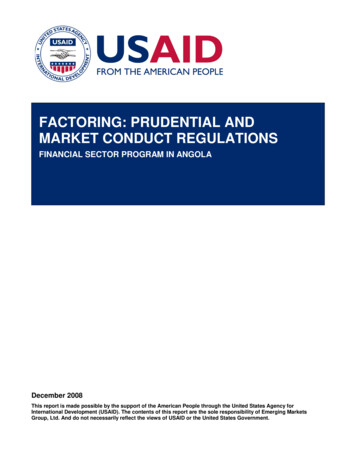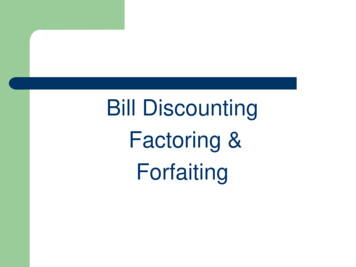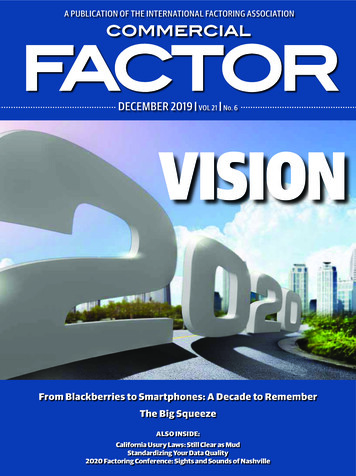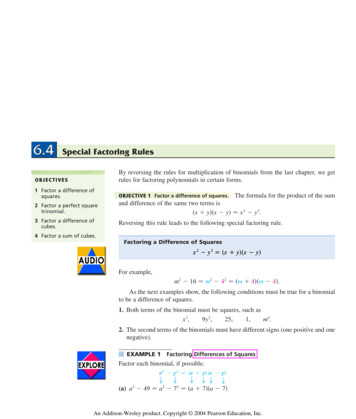
Transcription
SECTION 6.46.4Special Factoring Rules407Special Factoring RulesOBJECTIVESBy reversing the rules for multiplication of binomials from the last chapter, we getrules for factoring polynomials in certain forms.1 Factor a difference ofsquares.OBJECTIVE 1 Factor a difference of squares.2 Factor a perfect squaretrinomial.and difference of the same two terms is x y x y x 2 y 2.3 Factor a difference ofcubes.Reversing this rule leads to the following special factoring rule.The formula for the product of the sum4 Factor a sum of cubes.Factoring a Difference of Squaresx 2 y 2 x y x y For example,m2 16 m2 42 m 4 m 4 .As the next examples show, the following conditions must be true for a binomialto be a difference of squares.1. Both terms of the binomial must be squares, such asx 2,9y 2,25,1,m4.2. The second terms of the binomials must have different signs (one positive and onenegative).EXAMPLE 1 Factoring Differences of SquaresFactor each binomial, if possible.x 2 y 2 x y x y (a) a2 49 a2 72 a 7 a 7 An Addison-Wesley product. Copyright 2004 Pearson Education, Inc.
408CHAPTER 6Factoring and Applications(b) y 2 m2 y m y m (c) z 2 9 z2 16 342 z 34z 34(d) x 2 8Because 8 is not the square of an integer, this binomial is not a difference ofsquares. It is a prime polynomial.(e) p2 16Since p2 16 is a sum of squares, it is not equal to p 4 p 4 . Also, usingFOIL, p 4 p 4 p2 8p 16 p2 16and p 4 p 4 p2 8p 16 p2 16,so p2 16 is a prime polynomial.Now Try Exercises 7, 9, and 11.C A U T I O N As Example 1(e) suggests, after any common factor is removed,a sum of squares cannot be factored.EXAMPLE 2 Factoring Differences of SquaresFactor each difference of squares.x2 y2 x y x y (a) 25m2 16 5m 2 42 5m 4 5m 4 (b) 49z 2 64 7z 2 82 7z 8 7z 8 Now Try Exercise 13.As in previous sections, you should always check a factored form bymultiplying.NOTEEXAMPLE 3 Factoring More Complex Differences of SquaresFactor completely.(a) 81y 2 36First factor out the common factor, 9.81y 2 36 9 9y 2 4 9 3y 2 22 9 3y 2 3y 2 Factor out 9.Difference of squares(b) 9x 2 4z 2 3x 2 2z 2 3x 2z 3x 2z (c) p4 36 p2 2 62 p2 6 p2 6 Neither p2 6 nor p2 6 can be factored further.An Addison-Wesley product. Copyright 2004 Pearson Education, Inc.
Special Factoring RulesSECTION 6.4(d) m4 16 m2 2 42 m2 4 m2 4 m2 4 m 2 m 2 409Difference of squaresDifference of squares againNow Try Exercises 17, 21, and 25.C A U T I O N Remember to factor again when any of the factors is a differenceof squares, as in Example 3(d). Check by multiplying.OBJECTIVE 2 Factor a perfect square trinomial.are called perfect squares because144 122,4x 2 2x 2,The expressions 144, 4x 2, and 81m6and81m6 9m3 2.A perfect square trinomial is a trinomial that is the square of a binomial. For example, x 2 8x 16 is a perfect square trinomial because it is the square of the binomial x 4:x 2 8x 16 x 4 x 4 x 4 2.For a trinomial to be a perfect square, two of its terms must be perfect squares.For this reason, 16x 2 4x 15 is not a perfect square trinomial because only theterm 16x 2 is a perfect square.On the other hand, even if two of the terms are perfect squares, the trinomial maynot be a perfect square trinomial. For example, x 2 6x 36 has two perfect squareterms, x 2 and 36, but it is not a perfect square trinomial. (Try to find a binomial thatcan be squared to give x 2 6x 36.)We can multiply to see that the square of a binomial gives one of the followingperfect square trinomials.Factoring Perfect Square Trinomialsx 2 2xy y 2 x y 2x 2 2xy y 2 x y 2The middle term of a perfect square trinomial is always twice the product of thetwo terms in the squared binomial (as shown in Section 5.6). Use this rule to checkany attempt to factor a trinomial that appears to be a perfect square.EXAMPLE 4 Factoring a Perfect Square TrinomialFactor x 2 10x 25.The term x 2 is a perfect square, and so is 25. Try to factor the trinomial asx 2 10x 25 x 5 2.To check, take twice the product of the two terms in the squared binomial.2 x 5 10xTwiceFirst termof binomialLast termof binomialAn Addison-Wesley product. Copyright 2004 Pearson Education, Inc.
410CHAPTER 6Factoring and ApplicationsSince 10x is the middle term of the trinomial, the trinomial is a perfect square andcan be factored as x 5 2. Thus,x 2 10x 25 x 5 2.Now Try Exercise 33.EXAMPLE 5 Factoring Perfect Square TrinomialsFactor each trinomial.(a) x 2 22x 121The first and last terms are perfect squares 121 112 or 11 2 . Check to seewhether the middle term of x 2 22x 121 is twice the product of the first and lastterms of the binomial x 11.2 x 11 22xTwiceFirsttermLasttermSince twice the product of the first and last terms of the binomial is the middle term,x 2 22x 121 is a perfect square trinomial andx 2 22x 121 x 11 2.Notice that the sign of the second term in the squared binomial is the same as the signof the middle term in the trinomial.(b) 9m2 24m 16 3m 2 2 3m 4 4 2 3m 4 2TwiceFirstterm(c) 25y 2 20y 16The first and last terms are perfect squares.and25y 2 5y 2Lastterm16 42Twice the product of the first and last terms of the binomial 5y 4 is2 5y 4 40y,which is not the middle term of 25y 2 20y 16. This trinomial is not a perfectsquare. In fact, the trinomial cannot be factored even with the methods of the previous sections; it is a prime polynomial.(d) 12z 3 60z 2 75zFactor out the common factor, 3z, first.12z 3 60z 2 75z 3z 4z 2 20z 25 3z 2z 2 2 2z 5 52 3z 2z 5 2Now Try Exercises 35, 43, and 51.As mentioned in Example 5(a), the sign of the second term in thesquared binomial is always the same as the sign of the middle term in theNOTEAn Addison-Wesley product. Copyright 2004 Pearson Education, Inc.
SECTION 6.4Special Factoring Rules411trinomial. Also, the first and last terms of a perfect square trinomial must bepositive, because they are squares. For example, the polynomial x 2 2x 1cannot be a perfect square because the last term is negative.Perfect square trinomials can also be factored using grouping or FOIL,although using the method of this section is often easier.OBJECTIVE 3 Factor a difference of cubes. Just as we factored the difference ofsquares in Objective 1, we can also factor the difference of cubes using the following pattern.Factoring a Difference of Cubesx 3 y 3 x y x 2 xy y 2 This pattern should be memorized. Multiply on the right to see that the pattern givesthe correct factors.x 2 xy y 2x y x 2y xy 2 y 3x x 2y xy 2x3 y33Notice the pattern of the terms in the factored form of x 3 y 3. x 3 y 3 (a binomial factor)(a trinomial factor)The binomial factor has the difference of the cube roots of the given terms.The terms in the trinomial factor are all positive.What you write in the binomial factor determines the trinomial factor:First termsquaredx 3 y 3 x y x2 positiveproduct ofthe terms xy second termsquaredy 2 .The polynomial x 3 y 3 is not equivalent to x y 3, because x y can also be written as x y 3 x y x y x y x y x 2 2xy y 2 CAUTION3butx 3 y 3 x y x 2 xy y 2 .An Addison-Wesley product. Copyright 2004 Pearson Education, Inc.
412CHAPTER 6Factoring and ApplicationsEXAMPLE 6 Factoring Differences of CubesFactor the following.(a) m3 125Let x m and y 5 in the pattern for the difference of cubes.x 3 y 3 x y x 2 xy y 2 m3 125 m3 53 m 5 m2 5m 52 m 5 m2 5m 25 Let x m, y 5.(b) 8p3 27Since 8p3 2p 3 and 27 33,8p3 27 2p 3 33 2p 3 2p 2 2p 3 32 2p 3 4p2 6p 9 .(c) 4m3 32 4 m3 8 4 m3 23 4 m 2 m2 2m 4 (d) 125t 3 216s6 5t 3 6s2 3 5t 6s2 5t 2 5t 6s2 6s2 2 5t 6s 2 25t 2 30ts2 36s4 Now Try Exercises 59, 63, and 69.A common error in factoring a difference of cubes, such asx 3 y 3 x y x 2 xy y 2 , is to try to factor x 2 xy y 2. It is easy toconfuse this factor with a perfect square trinomial, x 2 2xy y 2. Becausethere is no 2 in x 2 xy y 2, it is very unusual to be able to further factor anexpression of the form x 2 xy y 2.CAUTIONA sum of squares, such as m2 25, cannot befactored using real numbers, but a sum of cubes can be factored by the following pattern, which should be memorized.OBJECTIVE 4 Factor a sum of cubes.Factoring a Sum of Cubesx 3 y 3 x y x 2 xy y 2 Compare the pattern for the sum of cubes with the pattern for the difference ofcubes. The only difference between them is the positive and negative signs.An Addison-Wesley product. Copyright 2004 Pearson Education, Inc.
SECTION 6.4Special Factoring Rules413Positivex 3 y 3 x y x 2 xy y 2 SamesignDifference of cubesOppositesignPositivex 3 y 3 x y x 2 xy y 2 SamesignSum of cubesOppositesignObserving these relationships should help you to remember these patterns.EXAMPLE 7 Factoring Sums of CubesFactor.(a) k 3 27 k 3 33 k 3 k 2 3k 32 k 3 k 2 3k 9 (b) 8m3 125 2m 3 53 2m 5 2m 2 2m 5 52 2m 5 4m2 10m 25 (c) 1000a6 27b3 10a2 3 3b 3 10a2 3b 10a2 2 10a2 3b 3b 2 10a2 3b 100a4 30a2b 9b2 Now Try Exercises 61 and 71.The methods of factoring discussed in this section are summarized here.Special FactorizationsDifference of squaresx 2 y 2 x y x y Perfect square trinomialsx 2 2xy y 2 x y 2x 2 2xy y 2 x y 2Difference of cubesx 3 y 3 x y x 2 xy y 2 Sum of cubesx 3 y 3 x y x 2 xy y 2 Remember the sum of squares can be factored only if the terms have acommon factor.An Addison-Wesley product. Copyright 2004 Pearson Education, Inc.
Observing these relationships should help you to remember these patterns. EXAMPLE 7. Factoring Sums of Cubes. Factor. (a) (b) (c) Now Try Exercises 61 and 71. The methods of factoring discussed in this section are summarized here. Special Factorizations. Difference of squares P


